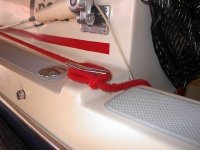As we approach putting the Accelerando in its slip, I am beginning to ponder lines, fenders and docking aids. And so I have a some questions:
For the midships (well roughly) fender, I assume you tie it to the vertical handrail, yes? If so, I assume you use a chafe guard on that line, yes? And for a breast line, would you also tie it to that handrail?
How do you deal with that forward cleat while docking? The Admiral is not keen on shimmying along that narrow gangway (or crawling through the hatch) to set a line there. In order to make this a little easier, my plan was to do something like Dr. Bob did, and mount a pad eye for a temporary spring line on the step below each window (or perhaps above the step, a little closer to the window for ease of reach). Then, we'd run those lines (port and starboard) back to the cockpit and store them there until we are ready to dock.
Next, one of the Admiral's requirements is that no one is making a jump for the dock. As she said this, I pondered calling her a wimp, but then reason (i.e. survival instinct) set in. Instead, I simply replied with "Yes mam; I'll find another solution."
So for those times there isn’t a dockhand, I have been looking at various docking aids like the Bosco 1000 or the Wrino boathooks. Have any of you ever used these? They look like they would be especially handy when singlehanding. There was also a product called the E-Z Docker (A hook on a rope that you throw on the dock). But this really only seems to work if the dock has a toe rail (or whatever that is called). Though I suppose you could toss it across the dock and hook the other side. Anyway, I can't find the manufacturer. They may have gone out of business.
Speaking of lines, are there some sort of nice line hangers or hooks that folks here use to hang your coiled lines to keep them handy?
Are there any other fender or line management/storage gadgets and gizmos I should know about?
I love useful gadgets and gizmos.
---
mike
For the midships (well roughly) fender, I assume you tie it to the vertical handrail, yes? If so, I assume you use a chafe guard on that line, yes? And for a breast line, would you also tie it to that handrail?
How do you deal with that forward cleat while docking? The Admiral is not keen on shimmying along that narrow gangway (or crawling through the hatch) to set a line there. In order to make this a little easier, my plan was to do something like Dr. Bob did, and mount a pad eye for a temporary spring line on the step below each window (or perhaps above the step, a little closer to the window for ease of reach). Then, we'd run those lines (port and starboard) back to the cockpit and store them there until we are ready to dock.
Next, one of the Admiral's requirements is that no one is making a jump for the dock. As she said this, I pondered calling her a wimp, but then reason (i.e. survival instinct) set in. Instead, I simply replied with "Yes mam; I'll find another solution."
So for those times there isn’t a dockhand, I have been looking at various docking aids like the Bosco 1000 or the Wrino boathooks. Have any of you ever used these? They look like they would be especially handy when singlehanding. There was also a product called the E-Z Docker (A hook on a rope that you throw on the dock). But this really only seems to work if the dock has a toe rail (or whatever that is called). Though I suppose you could toss it across the dock and hook the other side. Anyway, I can't find the manufacturer. They may have gone out of business.
Speaking of lines, are there some sort of nice line hangers or hooks that folks here use to hang your coiled lines to keep them handy?
Are there any other fender or line management/storage gadgets and gizmos I should know about?
I love useful gadgets and gizmos.
---
mike



